 W
WUSS Appalachian (AGC-1) was the lead ship of the Appalachian class amphibious force flagships of the United States Navy. She was laid down under a Maritime Commission contract on 4 November 1942 at the Federal Shipbuilding & Drydock Company in Kearny, New Jersey; launched on 29 January 1943, sponsored by Mrs. John Frank Mclnnis; acquired by the Navy on 27 February 1943; converted at Brooklyn, N.Y., by the Todd Shipbuilding Company for naval service as an amphibious flagship; and commissioned on 2 October 1943, with Captain James M. Fernald in command.
 W
WUSS Barbour County (LST-1195) was the seventeenth ship of the twenty Newport-class tank landing ships of the United States Navy (USN) which replaced the traditional bow door-design tank landing ships (LSTs). The vessel was named after two counties; one in Alabama, and the other in West Virginia. The LST was constructed by National Steel and Shipbuilding Company of San Diego, California. Barbour County was launched in 1971 and commissioned into the USN in 1972. Barbour County took part in the Vietnam War, including the evacuation of Saigon and the Gulf War. The LST also performed disaster relief in Bangladesh. The vessel was decommissioned in 1992 and laid up with plans to sell the ship. This did not happen and the vessel was struck from the Naval Vessel Register in 2001 and sunk as a target ship in 2004.
 W
WUSS Barr (DE-576/APD-39), originally a Buckley-class destroyer escort, and later a Charles Lawrence-class of the United States Navy named for Pvt. Woodrow Wilson Barr of Keyser, West Virginia.
 W
WUSS Berkeley County (LST-279) was an LST-1-class tank landing ship built for the United States Navy during World War II. Named for counties in South Carolina and West Virginia, she was the only U.S. Naval vessel to bear the name.
 W
WThe first USS Blue Ridge (ID-2432) was a steamship in the United States Navy. The ship was named for the Blue Ridge Mountains.
 W
WUSS Blue Ridge (AGC-2) was an Appalachian-class amphibious force flagship in the United States Navy. She was named for the southeasternmost ridge of the Appalachian Mountains in Virginia and North Carolina.
 W
WUSS Blue Ridge (LCC-19) is the first of the two Blue Ridge-class amphibious command ships of the United States Navy, and is the flagship of the Seventh Fleet. Her primary role is to provide command, control, communications, computers, and intelligence (C4I) support to the commander and staff of the United States Seventh Fleet. She is currently forward-deployed to U.S. Navy Fleet Activities, Yokosuka in Japan, and is the third Navy ship named after the Blue Ridge Mountains, a range of mountains in the Appalachian Mountains of the eastern United States. Blue Ridge is the oldest deployable warship of the U.S. Navy, following the decommissioning of USS Denver. Blue Ridge, as the U.S. Navy's active commissioned ship having the longest total period as active, flies the First Navy Jack instead of the jack of the United States. Blue Ridge is expected to remain in service until 2039.
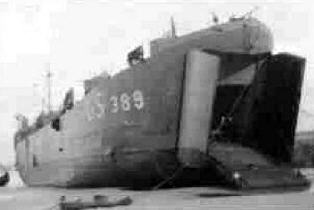 W
WUSS Boone County (LST-389) was an LST-1-class tank landing ship built for the United States Navy during World War II. Named for counties in Arkansas, Illinois, Indiana, Iowa, Kentucky, Missouri, Nebraska, and West Virginia, she was the only U.S. Naval vessel to bear the name.
 W
WUSS Cabell (AK-166) was an Alamosa-class cargo ship commissioned by the US Navy for service in World War II. She was responsible for delivering troops, goods and equipment to locations in the war zone.
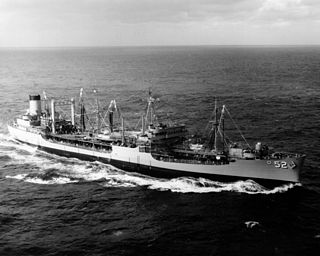 W
WUSS Cacapon (AO-52) was a T3 Cimarron-class fleet oiler acquired by the U.S. Navy during World War II. She served her country primarily in the Pacific Ocean Theater of Operations, and provided petroleum products where needed to combat ships. For performing this dangerous task, she was awarded battle stars and citations during World War II, the Korean War, and the Vietnam War.
 W
WUSS LST-519 was an LST-491-class tank landing ship built for the U.S. Navy in World War II. She was later renamed USS Calhoun County (LST-519 after counties in eleven states in the United States
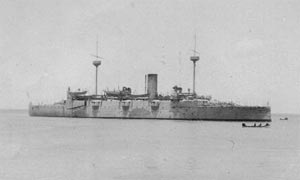 W
WThe second USS Charleston (C-2) was a United States Navy protected cruiser — the fourth US protected cruiser to be built. Lacking experience in building steel cruisers, the design was purchased from the British company Armstrong, Mitchell and Co. of Newcastle, the construction to be by an American shipyard. In design, she succeeded the "ABC" cruisers Atlanta, Boston, and Chicago with better protection, higher speed, and similar armament.
 W
WThe third USS Charleston (C-22/CA-19) was a United States Navy St. Louis-class protected cruiser. She was launched 23 January 1904 by Newport News Shipbuilding and Dry Dock Co., Newport News, Virginia, sponsored by Miss Helen Whaley Rhett, and commissioned on 17 October 1905, Captain Cameron McRae Winslow in command. She was reclassified CA-19 on 17 July 1920.
 W
WUSS Charleston (AKA-113/LKA-113) was an amphibious cargo ship, and was the lead ship of her class in the United States Navy. She was the fifth ship to be named Charleston for Charleston, South Carolina. She served as a commissioned ship for 23 years and 4 months.
 W
WUSS Claud Jones (DE-1033) was launched 27 May 1958 by Avondale Marine Ways, Avondale, Louisiana, sponsored by Mrs. M. R. J. Wyllie; and commissioned 10 February 1959, Lieutenant Commander W. M. Cone in command. The ship was named for Claud Ashton Jones.
 W
WUSS Grant County (LST-1174) was a De Soto County-class tank landing ship built for the United States Navy during the late 1950s. Named after counties in fifteen states, she was the only U.S. Naval vessel to bear the name.
 W
WUSS LSM(R)-507 was laid down on 31 March 1945 by the Brown Shipbuilding Company in Houston, Texas and launched on 28 April 1945. She was commissioned by the United States Navy on 22 June 1945, with Lieutenant Alvin G. Walser in command.
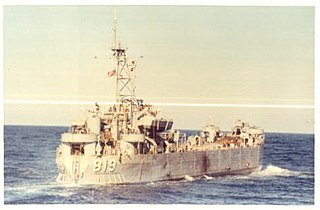 W
WUSS Hampshire County (LST-819) was an LST-542-class tank landing ship built for the United States Navy during World War II. Named for counties in Massachusetts and West Virginia, she was the only U.S. Naval vessel to bear the name.
 W
WUSS Harpers Ferry (LSD-49) is the lead ship of her class of landing ship dock of the United States Navy. This warship was named for the town of Harpers Ferry, West Virginia, which, because of the U.S. arsenal there, was an important location during the Civil War. USS Harpers Ferry is assigned to the Navy's "Amphibious Group 1". The homeport of Harpers Ferry is at San Diego County, California. Harpers Ferry was previously stationed at the American Naval Base in Sasebo, Nagasaki, Japan before she was relieved in 2011 by USS Germantown.
 W
WUSS Herbert J. Thomas (DD-833) was a Gearing-class destroyer of the United States Navy. Named for Sergeant Herbert Joseph Thomas Jr., USMC, she was laid down on 30 October 1944 by Bath Iron Works Corporation, Bath, Maine; launched on 25 March 1945; sponsored by Miss Audrey Irene Thomas, sister of Sergeant Thomas; and commissioned on 29 May 1945, Commander Robert T. S. Keith in command.
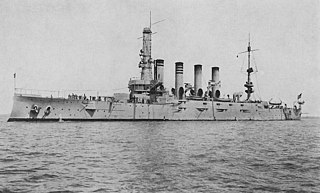 W
WThe first USS West Virginia (ACR-5/CA-5), also referred to as "Armored Cruiser No. 5", and later renamed Huntington, was a United States Navy Pennsylvania-class armored cruiser.
 W
WUSS Cowpens (CV-25/CVL-25/AVT-1), nicknamed The Mighty Moo, was an 11,000-ton Independence class light aircraft carrier that served the United States Navy from 1943 to 1947.
 W
WUSS Huntington (CL-107), a Fargo-class light cruiser, was the second ship of the United States Navy named after the city of Huntington, West Virginia. She was built during World War II but not completed until after the end of the war and in use for only a few years.
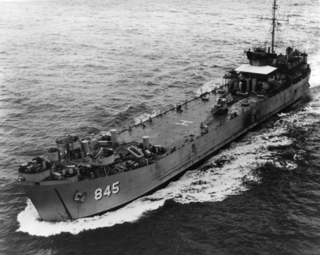 W
WUSS Jefferson County (LST-845) was an LST-542-class tank landing ship built for the United States Navy during World War II. Named after counties in 25 states, she was the only U.S. Naval vessel to bear the name.
 W
WUSS John Marshall (SSBN-611) was an Ethan Allen-class submarine, the only ship of the United States Navy to be named for John Marshall (1755–1835), the fourth Chief Justice of the United States. Originally a fleet ballistic missile submarine designated SSBN-611, she later was reclassified as an attack submarine and re-designated SSN-611.
 W
WUSS Kanawha was a Unadilla-class gunboat built for the Union Navy during the American Civil War. She was used by the navy to patrol navigable waterways of the Confederacy to prevent the South from trading with other countries.
 W
WUSS Kanawha (AO–1) was the lead ship of her class of replenishment oilers of the United States Navy. She was commissioned in 1915 and sunk on 8 April 1943 by Japanese aircraft off Tulagi, Solomon Islands.
 W
WUnited States Naval Ship USNS Kanawha (T-AO-196) is a Henry J. Kaiser-class fleet replenishment oiler of the United States Navy in non-commissioned service in the Military Sealift Command.
 W
WUSS Kinzer (APD-91), ex-DE-232, was a United States Navy high-speed transport in commission from 1944 to 1946.
 W
WUSS Lincoln County (LST-898) was an LST-542-class tank landing ship built for the United States Navy during World War II. Named after counties in 23 U.S. states, she was the only U.S. Naval vessel to bear the name.
 W
WUSS Berkeley County (LST-279) was an LST-1-class tank landing ship built for the United States Navy during World War II. Named for counties in South Carolina and West Virginia, she was the only U.S. Naval vessel to bear the name.
 W
WUSS Boone County (LST-389) was an LST-1-class tank landing ship built for the United States Navy during World War II. Named for counties in Arkansas, Illinois, Indiana, Iowa, Kentucky, Missouri, Nebraska, and West Virginia, she was the only U.S. Naval vessel to bear the name.
 W
WUSS Monongahela (1862) was a barkentine–rigged screw sloop-of-war that served in the Union Navy during the American Civil War. Her task was to participate in the Union blockade of the Confederate States of America. Post-war, she continued serving her country in various roles, such as that of a storeship and schoolship.
 W
WThe second USS Monongahela (AO-42) was a Kennebec-class oiler in the United States Navy which saw service during World War II and the Korean War. She was the second U.S. Navy ship named for the Monongahela River in West Virginia and Pennsylvania.
 W
WUSS Morgan County (LST-1048) was an LST-542-class tank landing ship built for the United States Navy in World War II. Like most ships of her class, she was originally known only by her designation, USS LST-1048, and, like all remaining LSTs, was named on 1 July 1955, after eleven counties in the U.S.
 W
WUSS Potomac was a frigate in the United States Navy laid down by the Washington Navy Yard in August 1819 and launched in March 1822. Fitting out was not completed until 1831, when Captain John Downes assumed command as first commanding officer. Although called a "44" 1st class, she was built to mount 32 carronades on her spar deck, 30 long guns on her gun deck, two bow and three stern chasers on each of these decks, significantly under-rating her on the rating system of the Royal Navy.
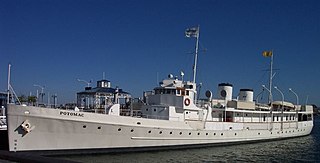 W
WUSS Potomac (AG-25), formerly USCGC Electra, was Franklin D. Roosevelt's presidential yacht from 1936 until his death in 1945. In January 2016 USS Williamsburg was scrapped leaving USS Potomac and USS Sequoia as the last two still existing presidential yachts. On 3 August 1941, she played a decoy role while Roosevelt held a secret conference to develop the Atlantic Charter. She is now preserved in Oakland, California, as a National Historic Landmark and the only presidential yacht open to the public.
 W
WUSNS Sgt. Jonah E. Kelley (T-APC-116), was originally built as Link Splice under a United States Maritime Commission contract and was laid down on 29 January 1945 by the Southeastern Shipbuilding Corporation in Savannah, Georgia. She was launched on 17 March 1945, sponsored by Mrs. L. W. Grothaus and delivered to the War Shipping Administration for operation by the Moore McCormack Lines on 28 August 1945.
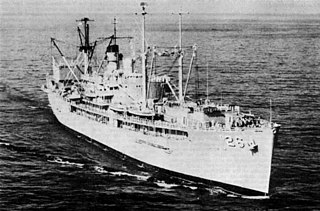 W
WUSS Shenandoah (AD-26) was one of ten planned destroyer tenders built at the tail end of World War II. The lead ship in her class, she was the third United States naval vessel named for the Shenandoah River which runs through Virginia and West Virginia.
 W
WUSS Shenandoah was the first of four United States Navy rigid airships. It was constructed during 1922–1923 at Lakehurst Naval Air Station, and first flew in September 1923. It developed the U.S. Navy's experience with rigid airships and made the first crossing of North America by airship. On the 57th flight, Shenandoah was destroyed in a squall line over Ohio in September 1925.
 W
WCSS Shenandoah, formerly Sea King, later El Majidi, was an iron-framed, teak-planked, full-rigged sailing ship with auxiliary steam power chiefly known for her actions under Lieutenant Commander James Waddell as part of the Confederate States Navy during the American Civil War.
 W
WKōtetsu , later renamed Azuma , was the first ironclad warship of the Imperial Japanese Navy. She was designed as an armored ram for service in shallow waters, but also carried three guns. The ship was built in Bordeaux, France, for the Confederate States Navy under the cover name Sphinx, but was sold to Denmark after sales of warships by French builders to the Confederacy was forbidden in 1863. The Danes refused to accept the ship and sold her to the Confederates which commissioned her as CSS Stonewall in 1865. The ship did not reach Confederate waters before the end of the American Civil War in April and was turned over to the United States.
 W
WUSS Stonewall Jackson (SSBN-634), a James Madison-class fleet ballistic missile submarine, was the third ship of the United States Navy to be named for Confederate States Army General Thomas J. "Stonewall" Jackson (1824–1863).
 W
WUSS Stump (DD-978) was a Spruance-class destroyer built by the Ingalls Shipbuilding Division of Litton Industries at Pascagoula, Mississippi. The USS Stump was decommissioned and stricken on 22 October 2004.
 W
WThe first USS West Virginia (ACR-5/CA-5), also referred to as "Armored Cruiser No. 5", and later renamed Huntington, was a United States Navy Pennsylvania-class armored cruiser.
 W
WUSS West Virginia (BB-48) was the fourth dreadnought battleship of the Colorado class, though because Washington was cancelled, she was the third and final member of the class to be completed. The Colorado class proved to be the culmination of the standard-type battleship series built for the United States Navy in the 1910s and 1920s; the ships were essentially repeats of the earlier Tennessee design, but with a significantly more powerful main battery of eight 16-inch (406 mm) guns in twin-gun turrets. West Virginia was built between her keel laying in 1920 and her commissioning into the Navy in 1923. The ship spent the 1920s and 1930s conducting routine training exercises, including the typically-annual Fleet Problems, which provided invaluable experience for the coming war in the Pacific.
 W
WUSS West Virginia (SSBN-736) is a United States Navy Ohio-class ballistic missile submarine. She has been in commission since 1990. She is the third U.S. Navy ship to be named for West Virginia, the 35th state, and the 11th of 18 Ohio-class submarines.
 W
WUSS Wood County (LST-1178) was a De Soto County-class tank landing ship built for the United States Navy during the late 1950s. Named after counties in Ohio, Texas, West Virginia, and Wisconsin, she was the only U.S. Naval vessel to bear the name.